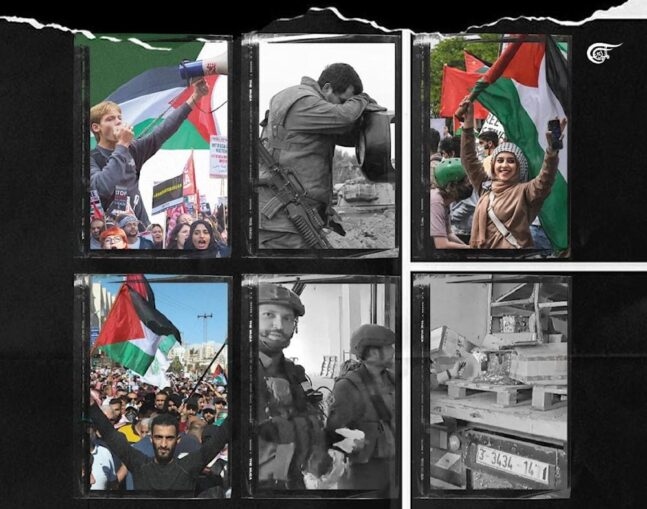
The current strategy in Gaza was designed to satiate not only Netanyahu’s base, who since 2005 have dreamt to once again occupy its shores, but to derail the struggle for national liberation throughout historic Palestine.
In the latest stream of videos from besieged Gaza, two Israeli soldiers stand side by side atop a seized building. One calmly lights a cigarette, when suddenly in the foreground a residential block erupts into smoke and ash. Their faces contort into sadistic glee, and they offer both the viewer and fellow compatriots a look at their work, beaming with pride.
In another piece of footage, a row of Palestinian men stand at gunpoint, bound and almost nude. An Israeli soldier is heard shouting, “Whose fault is all of this?”. The bound men respond, in visible distress: “Hamas”. In the eyes of Israeli soldiers, Israeli politicians, and Zionism’s fervent adherents both inside and outside the state there is resolute determination not only to humiliate, but to annihilate: every ounce of defiance, every breath of resistance—be it man, woman, or child. It is no longer enough to “mow the grass in Gaza”; the 41 kilometer territory must be turned from abattoir to uninhabitable wasteland.
At this moment, we are observers of the Palestinian reality, that this war, this open genocide, is not about the existence of any abductees, or even for the sake of purported democracy. This war is for the existence of the state itself.
Historically, architects of the “Israel” have never been satisfied with massacres—the ethnic cleansing of the land’s native population has been a coordinated, and unremitting strategy. In 1940, Yosef Weitz, director of the Land and Afforestation Department of the Jewish National Fund, who led the state’s earliest efforts to ethnically cleanse indigenous Palestinians, described the necessity of implementing a plan of expulsion in order for the state to survive:
“Between ourselves it must be clear that there is no room for both peoples together in this country …We shall not achieve our goal of being an independent people with the Arabs in this small country. The only solution is a Palestine, at least Western Palestine (west of the Jordan River) without Arabs…And there is no other way than to transfer the Arabs from here to the neighboring countries, to transfer all of them: Not one village, not one tribe, should be left…Only after this transfer will the country be able to absorb the millions of our own brethren. There is no other way out.”
In 1948, “Israel” would strategically launch Plan Dalet, during which the Stern Gang, the Haganah, and the Irgun would coordinate a pivotal campaign of death and terror in order to facilitate the conquest of Palestine. The massacres of Deir Yassin and Tantura—two of many instrumental massacres—would come to symbolise the colonial state’s violent endgame for Palestinians. A majority of the inhabitants of Gaza, who are themselves descendants of the Nakba, are being forcefully driven out, and confronted with a merciless crusade of extermination. These are the skeletons that haunt both “Israel” and its present facilitators, namely the United States; it is why there can be no separating the Nakba, the expulsion of 700,000 Palestinians, from the “Israel” of today. The crime is one and the same, and the criminals are one and the same.
“Israel” is an invention borne of imperial imagination, one which refuses to relinquish its grip and influence on the region—and it cannot exist without calculated subsidisation from imperial powers and neighbouring vassal states. The Biden administration’s policy on the client garrison-state of “Israel” is one of unbreakable symbiotic attachment; it is a valued appendage of the United States military-industrial complex, highly weaponized from inception. “Imagine our circumstances in the world were there no Israel. How many battleships would there be? How many troops would be stationed,” Joe Biden asked in 2007.
In the American mind, to imagine a world outside of imperial control, without colonial subordinates, is to envisage the collective failure of US political and military power; to conjure up the death knell of what Frantz Fanon called a machine of naked, violent oppression. In equal confidence, to onlookers of the incalculable devastation in Gaza, these circumstances seem insurmountable. And yet, it is in the midst of this oppressive miasma of despair that the most formidable acts of resistance have been born.
The current strategy in Gaza was designed to satiate not only Netanyahu’s base, who since 2005 have dreamt to once again occupy its shores, but to derail the struggle for national liberation throughout historic Palestine. Despite all the celebratory killing that is being shared with pride by Israeli soldiers, its occupying forces have only accomplished one thing: they have helped chip away at “Israel’s” coveted hasbara. And so, the state tiredly limps forward, the Israeli reality closing in.
In Gaza, “Israel” has attempted to bury even the sunlight behind the fog of war, but to the occupation’s dismay, and with growing intensity, fists are being raised from every corner of the earth in solidarity with and in defense of the people of Palestine—from Lebanon, Yemen, Syria, and Iraq; from steadfast houses in the South, and defiant quarters in the East: Resistance is the compass, written in blood and ink, and its name is Palestine.
Roqayah Chamseddine
https://english.almayadeen.net/articles/blog/skeletons-of-the-past–crimes-of-the-present